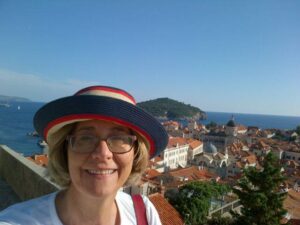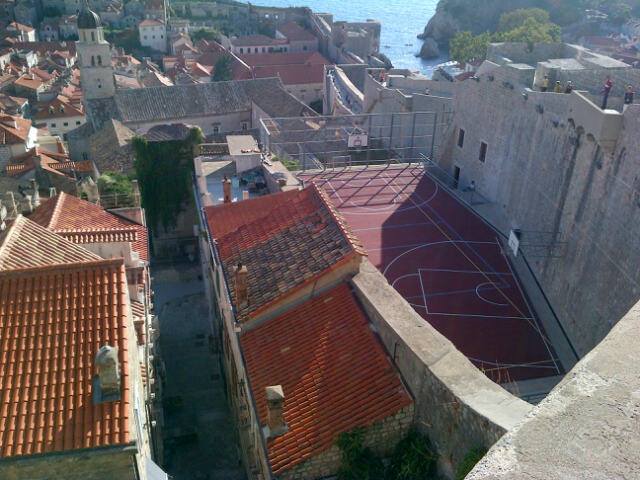It was hard to photograph using the camera on my out-of-date Blackberry. But look closely: stretched across the rooftops of stone houses inside Dubrovnik’s Medieval walls is a basketball court. Oddly shaped, but there it sits, perched three stories up. Isn’t it clever?
Well, where else can you put a basketball court in a mountainside town? The entire city of Dubrovnik cascades down from the imposing Dalmatian mountains. Down, down, the narrow alleys tumble, down to the sparkling beaches and into the clear waters of the Adriatic Sea.
At September’s end, tourism in Dubrovnik has entered the “low season.” But there are still swarms of tourists, especially when the cruise ships dock. Tourists fill the piazzas (yes, they use much Italian here). And most visitors tour the walls, picking their way up the unfriendly stone steps, steadying themselves as they snap hundreds of pictures of the tile rooftops and azure sea. It takes close to two hours to visit each and every crevice along the walls, peering down into the alleyways and discovering things like this basketball court.
 The economy of Dubrovnik depends on tourism, as does the entire Adriatic Coast. The horrors of the 1991-1995 Homeland War nearly ruined the tourist industry, but it recovered. It shakes a person to think what occurred in these legendary coastal cities just 20 years ago as Serbs and Croats clashed. It’s even more impressive to see how the Medieval walls of Dubrovnik stood up to shelling by modern weaponry!
The economy of Dubrovnik depends on tourism, as does the entire Adriatic Coast. The horrors of the 1991-1995 Homeland War nearly ruined the tourist industry, but it recovered. It shakes a person to think what occurred in these legendary coastal cities just 20 years ago as Serbs and Croats clashed. It’s even more impressive to see how the Medieval walls of Dubrovnik stood up to shelling by modern weaponry!
When I first visited Dubrovnik in 1986, Yugoslavia’s prosperity under Tito was still apparent. Six years had passed since his death but the shadow of his power still kept the disparate ethnicities together.
But just barely. The centuries’ old strife between Croats, Serbs, and Bosnians reared its head when Slovenia declared independence from the composite country of Yugoslavia in 1991. Croatia followed quickly, and the response in Milosevic’s Belgrade was to send in the Yugoslav army. The Croats scrambled to assemble their own army, and the crisis deepened.
The four-year Homeland War was messy, horrifying. Bombed churches and Renaissance palaces, shattered villages: all in a land so recently united in “brotherhood.” Today’s peace between Croats, Serbs, Bosnians, Slovenian, and Montenegrins, while valued, is not an easy one.
Some factors are still in play, not the least of which is “Who has access to the sea?” A critical trade route since the Byzantine Empire, the coastline of Adriatic Sea defines the economy and is essential for the tourism that drives this sun-baked paradise.
In the post-Homeland War period, Croatia possesses the coastline today—territory that historically was hers. But there is a single exception.
An hour north of Dubrovnik, we drove through stretch of about 9 miles that gives Bosnians access to a sea channel (if not direct access to the sea). We made a rest stop there. It really didn’t look so different, except for being densely populated. In fact, the town was dominated by a steeple of a Catholic Church and a cross on the hill.
But when we entered the restaurant at our stop, things felt different. It was hard to define, but we were in a different country, one that is primarily Muslim.. I found myself wondering: “Who will rule this stretch of miles 50 or100 years from now?”
You cannot escape the shifting fate of politics in today’s Croatia. It is a menacing cloud that never passes. Conflict has defined, and will continue to define, the Adriatic Coast. Dubrovnik will remain a place where Medieval walls can absorb high-tech bullets. But it is also a spot where a quiet surface for playing Croatia’s beloved sport of basketball can lie peacefully on the rooftops.




